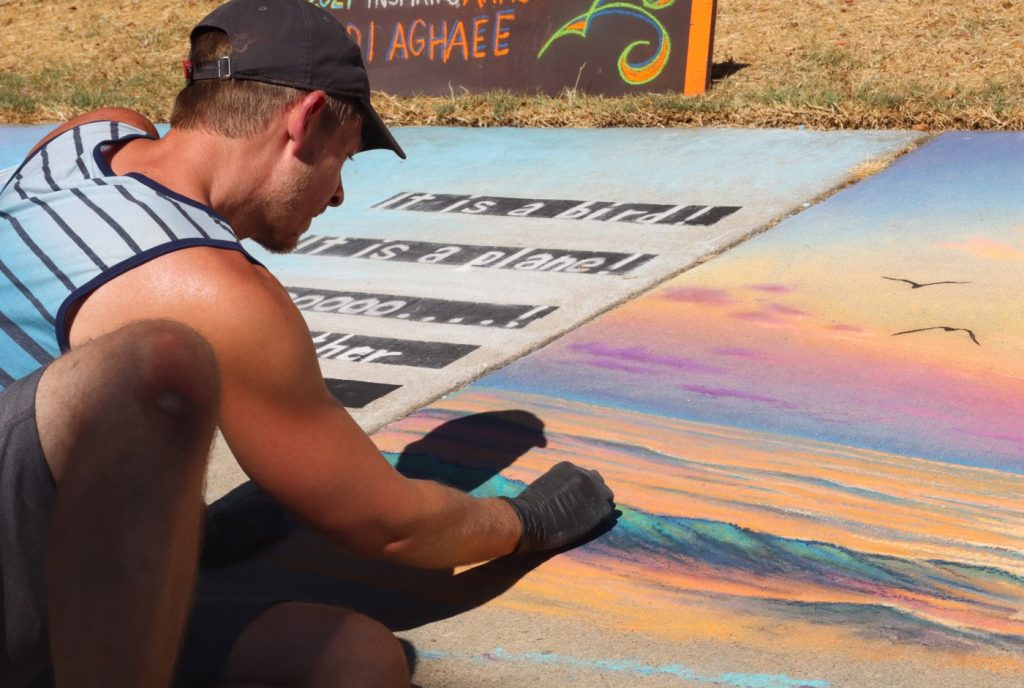Editor’s Note: This article was written for Mosaic, an independent journalism training program for high school students who report and photograph stories under the guidance of professional journalists.
A crowd of teenagers sat on the sun-warmed concrete sidewalk, their fingers streaked with bright hues of blue, red, and yellow, as they transformed the pavement into a vibrant mural with sticks of chalk.
The students, members of Lincoln High School’s National Honor Society, were just one of many groups adding their artistic touch to the 17th annual Luna Park Chalk Art Festival on Sept. 21. For them, this festival is a yearly highlight — a time to bond over art and share their passion with the broader community.
“Everyone comes together to design something special,” said Nerou Collins, an artist and club member. “It’s always a great event, especially with newer members. They see how fun and meaningful art can be when shared with the community.”
The festival, hosted at San Jose’s Backesto Park, drew thousands of spectators and artists of all skill levels, from casual hobbyists to seasoned professionals. More than 25 youth art groups came to the festival, including from areas as distant as Santa Cruz. More than just a creative outlet, the event raises critical funds for youth art programs in underserved schools, making it both a celebration of artistry and a way to support arts education in the community.
One of the festival’s key goals is to ensure that young artists, especially those from low-income schools, have access to resources and opportunities. Carol Beebe, the board treasurer of the Luna Park Arts Foundation, spoke about the foundation’s commitment to offering grants for youth groups participating in the festival.
“We recently switched from an application-based grant process to just offering grants to all participating schools and youth groups, in order to be more accessible,” she said. “This year, each youth group will be getting $100 from us for every chalk square that they signed up for.”
These grants can give teachers the extra help needed to buy necessary art materials for students. Millie Crosby, a teacher at Trace Elementary School in San Jose, plans to use the grant to enhance her classroom.
“I’ve experienced cuts to art programs at schools I taught at because of a lack of funding,” she said. “Trace Elementary School is a Title I school, meaning we service a lot of low-socioeconomic status families, so the $100 art grant is definitely a help.”
Nili Gold, vice president of the Luna Park Arts Foundation, believes that a critical part of the organization’s mission is to uplift struggling art teachers.
“We hear regularly from teachers that they don’t have enough funding in the school to buy the art supplies they need to make their classes work,” he said. “They end up spending their own money on these materials, so being able to supplement that is one of the main reasons we continue this festival year after year.”
Related Articles
San Jose’s Little Italy celebrates with spirit — plus music, crafts and pizza
Young readers fall in love with ‘romantasies’
Opinion: Why this student is X-ing out Latinx
Opinion: My family calls me unruly. So what if I am?
However, the chalk art festival seeks to go beyond simply fundraising by also fostering creativity within the community. Audrey Genrich, a student artist from Herbert Hoover Middle School, appreciates how the event built a sense of togetherness and belonging.
“This festival is very inclusive to different levels of artists, because if you’re not that good, this is a place where you can still express yourself with art and you can also see these amazing, masterful art pieces by professionals,” Genrich said.
Cheryl Renshaw, one of the featured “Inspiring Artists” at the event, agrees that the festival provides a unique opportunity for facilitating more community engagement in the arts.
“Most of the time you just see art on the wall of the gallery, and there’s a disconnect between the viewer and the artist,” Renshaw said. “Here, people can talk to the artists and see how they do things. It’s a very approachable event.”
Ella Polak is a senior at Leland High School in San Jose.


